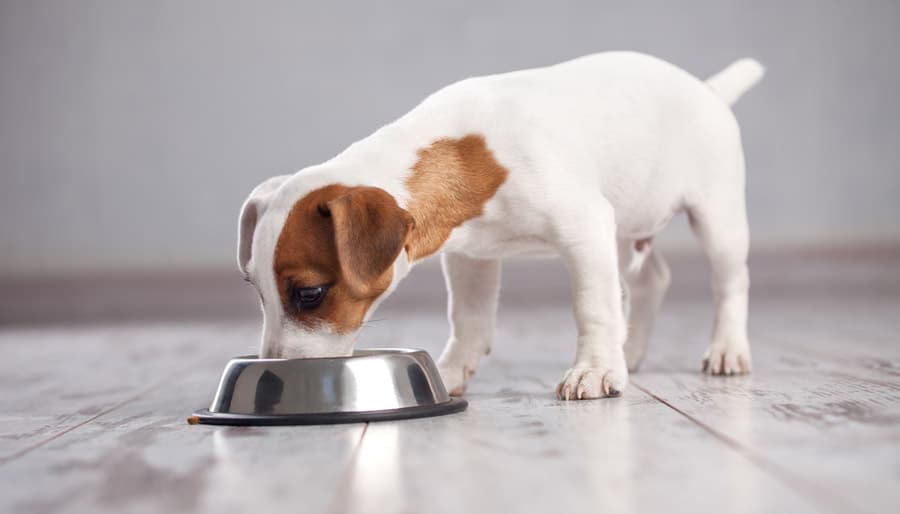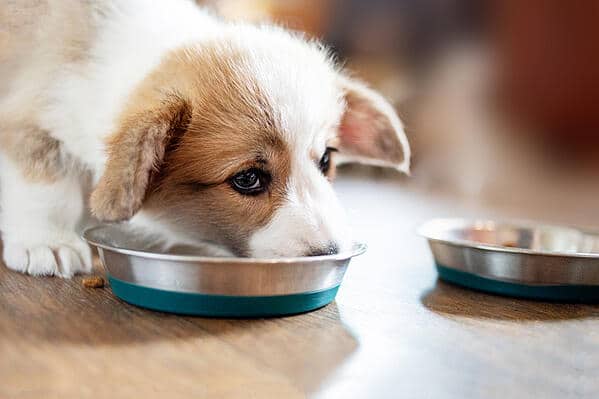Puppies grow so quickly. And giving them the right diet is vital for helping them build strong bones and teeth, adding muscles, and supplying them with the energy they need for playing and learning. At some point in time, the mother dog is going to decide that enough nursing has happened and the puppies should be introduced to puppy food. She will begin giving the puppies less milk for various reasons, including weak lactation and puppies causing her pain with their milk teeth.
As a dog parent, therefore, you need to keep an eye on the food intake of your puppies and know the right time to introduce them to wet food. While most dogs will start introducing their puppies to wet food on their own (or naturally), you can always lend a helping paw.
When to Start Feeding Puppies Wet Food

So, when should you introduce your puppies to wet food? The short answer is: 3-4 weeks. This is usually when the weaning process in most dogs begin. For starters, weaning simply describes the transition of a puppy’s diet from a mother’s milk to solid diet. Most canine experts recommend 3-4 weeks because:
- It is when puppies begin to grow their milk teeth, which are incredibly sharp and can injure the sensitive teeth of their mother.
- It is now that puppies can begin chewing regular food, thanks to their milk teeth.
- At this stage, puppies may not get all the calories that their bodies need from the mother’s milk.
- The discomfort of the puppies’ milk teeth may cause the mother to pull away before the puppies get completely satisfied. As a result, the puppies will seek alternative sources of food.
However, orphaned dogs or those with behavioral issues may take longer than 3-4 weeks to wean, so you should always keep this fact in mind. That being said, the best time to start feeding your puppies wet food could be immediately you notice that their mother is running out of milk supply or growing thin. An additional hint that you can rely on is the first sight of milk teeth from the pups—which often start at about 3 weeks in most breeds.
The sooner you introduce puppies to wet food, the less strain they will put on their mother, and the sooner she will return to her normal condition in terms of weight and overall health. In fact, if you have hand-raised the puppies for any reason, the faster they are introduced to wet food the better.
Quick Tips to Remember When Introducing Puppies to Wet Food

- Natural weaning entails the mother regurgitating food for her puppies. Some dogs will do this, so it shouldn’t be a concern to you. It is a natural maternal function and nothing should worry you.
- If the puppies don’t seem interested in the wet food you are offering them, consider dipping your fingers in the food and then touching their mouths so that they can taste it. Beware: they might get messy when exploring this new food and arming yourself with a few dog drool bibs may come in handy.
Related Posts: 12 Best Dog Drool Bibs in 2020
- Each puppy will get used to wet food on an individual basis. So, if you notice that one puppy is lagging behind, continue giving him the food in the presence of another puppy.
- Canine nutritionists recommend serving puppies wet food at room temperature because it easier to digest and smells good. If you always refrigerate your puppy food, consider removing them a few hours before meals or microwaving the food for a few minutes.
- Puppies’ stomachs are sensitive and can easily get upset. So, change their food sparingly. If you have to change the wet food, ensure that you give their tummies enough time to adjust. You can do this by mixing 25% of the new food with 75% of the old one and gradually increasing the percentage of the new food until you reach a point when you are feeding them only the new food.
Related Posts:
20 Dog Breeds Prone to Sensitive Stomachs
- Some breeders begin by giving the mother wet puppy foods to not only provide her with extra nourishment but also to encourage the puppies to learn eating the food. Puppies might begin sampling some of their mum’s food as sign that they are ready to be fed the same food or weaned.
- Because of their small stomachs, puppies cannot digest much food in a single seating, so ensure that you feed them small amounts but often.
- Food hygiene should a priority to avoid cross-contamination
- Work closely with a vet to help you figure out a diet that is specific to your puppies’ needs. Calcium-phosphorus ratio, for instance, should always be balanced lest you end up with puppies with orthopedic issues like osteochondrosis or hip dysplasia.
Related Posts:
12 Best Joint Supplements for Dogs with Hip Dysplasia
10 Best Dog Knee Braces for Dogs with Luxating Patella (Grade 1 & 2)
Final Thoughts
Introducing puppies to solid food is a critical part of their physical and emotional growth towards being independent. Knowing when to start feeding puppies wet food can, therefore, go a long way in helping them grow into healthy young pups. At first, feeding the puppies may be a bit overwhelming—some puppies will not be willing to eat the food, you may need to wipe the puppies after meals as some will wear as much food as they consume, choosing the right food may be confusing, etc. But common sense coupled with advice from your vet will make it an easy and worthwhile process.
Related posts:
When Should You Switch A Puppy to 2 Meals A Day?
How Much Canned Food Should You Feed a Dog Per Day?
Can I Mix Cat Food with Dog Food?
How Much Weight Should A Puppy Gain Per Week?
As an Amazon Associate, we may receive a small commission from qualifying purchases but at no extra cost to you. Learn more. Amazon and the Amazon logo are trademarks of Amazon.com, Inc, or its affiliates.

